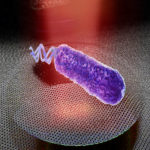News, Bacterial soundtracks revealed by graphene membrane
Have you ever wondered if bacteria make distinctive sounds? If we could listen to bacteria, we would be able to know whether they are alive or not. When bacteria are killed using an antibiotic, those sounds would stop – unless of course the bacteria are resistant to the antibiotic. This is exactly what a team of researchers from TU Delft , led by dr. Farbod Alijani, now have managed to do: they captured low-level noise of a single bacterium using graphene. Now, their research is published in Nature Nanotechnology.
Farbod Alijani’s team was originally looking into the fundamentals of the mechanics of graphene, but at a certain point they wondered what would happen if this extremely sensitive material comes into contact with a single biological object.
“Graphene is a form of carbon consisting of a single layer of atoms and is also known as the wonder material,” says Alijani. “It’s very strong with nice electrical and mechanical properties, and it’s also extremely sensitive to external forces.”
The team of researchers initiated a collaboration with the nano biology group of Cees Dekker and the nanomechanics group of Peter Steeneken. Together with PhD student Irek Roslon and postdoc Dr. Aleksandre Japaridze, the team ran their first experiments with E. coli bacteria. Cees Dekker: “What we saw was striking! When a single bacterium adheres to the surface of a graphene drum, it generates random oscillations with amplitudes as low as a few nanometers that we could detect. We could hear the sound of a single bacterium!”
Learn about our two Decals!
 Click here to find out more about our Fall Bioinspired Design Decal and our Spring Bioinspired Design in Action Decal – ALL MAJORS are welcome.
Click here to find out more about our Fall Bioinspired Design Decal and our Spring Bioinspired Design in Action Decal – ALL MAJORS are welcome.Berkeley BioDesign Community
 Click here to learn about the BioD: Bio-Inspired Design @ Berkeley student organization or here to signup for more info.
Click here to learn about the BioD: Bio-Inspired Design @ Berkeley student organization or here to signup for more info.Search
Student Login




I imagine that the neurological circuits underlying these processes are governed by both 2d spacing maps with their brains as…
to reduce the impact of car accidents, it may be possible to study the force diverting physics of cockroaches to…
you see this type of head-bobbing stability in many avian creatures related to pigeons like chickens. the head ability to…
not like they taught horses how to run! this is an example of convergent evolution where both sea creatures and…
The brain functions in a similar way with neuronal connections. our brains are able to utilize the multiplicity of connections…